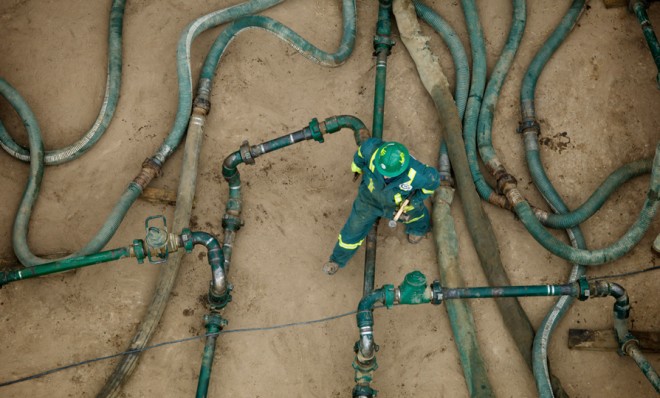Does fracking cause earthquakes?
A new study says frack-quakes really did occur in 2011

More than 100 earthquakes in 2011 in Youngstown, Ohio, were caused by fracking, says a new study, adding to past research that has linked fracking to earthquakes in Oklahoma and Arkansas.
Youngstown is located over the Marcellus Shale, a geological formation that scientists estimate contains 489 trillion cubic feet of natural gas. Before January 2011, it had never felt an earthquake, at least not since record-keeping began in 1776. But two weeks after the Northstar 1 well started pumping fluid into the ground, the tremors began. Though most were too small to feel, by December 2011 seismometers in the town had recorded a magnitude 3.9 quake.
The Ohio Department of Natural Resources quickly responded, "The seismic events are not a direct result of fracking." But the well was shut down for investigation, after which the tremors stopped. This week's report, published in the Journal of Geophysical Research, contradicts the director's claim.
The Week
Escape your echo chamber. Get the facts behind the news, plus analysis from multiple perspectives.

Sign up for The Week's Free Newsletters
From our morning news briefing to a weekly Good News Newsletter, get the best of The Week delivered directly to your inbox.
From our morning news briefing to a weekly Good News Newsletter, get the best of The Week delivered directly to your inbox.
The earthquakes "were induced by the fluid injection at Northstar 1," says study author Won Young Kim of Columbia University. Researchers say 167 distinct earthquakes resulted from that one well.
How did the researchers determine that Northstar 1 was to blame? For one, they found that the frequency and intensity of the quakes altered in accordance with the daily pressure levels in the well. Also, the epicenter of each of the quakes was either at the well or along the fault line that the well was connected to.
The well was pumping water into the ground at a rate of about 1,300 gallons per hour. National Journal's Brian Resnick explains it like this:
What seemed to happen was that the high-pressure fluid moved along a preexisting fault in a west-southwest direction (away from the well), increasing pressure on the rock formations as it progressed. This decreased the resistance the rock had to faulting, which increased the risk of an earthquake. And the location of the seismic activity moved as the the fluid did, along the fault line. When the pumping at the well stopped, the study concludes, the earthquakes waned. [National Journal]
Resnick also points out that Northstar 1 was the only such well in Ohio during that time period to cause any quakes. So what makes Youngstown so vulnerable?
A free daily email with the biggest news stories of the day – and the best features from TheWeek.com
It seems that the Ohio's Department of Natural Resources didn't realize that a fault line ran beneath the well. "Ironically, the data needed to make that determination was already available," explains The Energy Collective, but because funds were short, and no federal regulations required the data, it eluded the state and the builders.
"It’s a classic look at what can happen when a new industry booms, and only as it is proliferates unregulated does the collateral damage become apparent," says The New Republic. "At least Ohio is experimenting with solutions."
Carmel Lobello is the business editor at TheWeek.com. Previously, she was an editor at DeathandTaxesMag.com.
-
 US citizens are carrying passports amid ICE fears
US citizens are carrying passports amid ICE fearsThe Explainer ‘You do what you have to do to avoid problems,’ one person told The Guardian
-
 All roads to Ukraine-Russia peace run through Donetsk
All roads to Ukraine-Russia peace run through DonetskIN THE SPOTLIGHT Volodymyr Zelenskyy is floating a major concession on one of the thorniest issues in the complex negotiations between Ukraine and Russia
-
 Why is Trump killing off clean energy?
Why is Trump killing off clean energy?Today's Big Question The president halts offshore wind farm construction